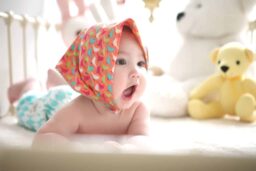In 2000, the Early Hearing Detection and Intervention (EHDI) program was established to ensure children with hearing loss receive the support they need as early as possible.

This initiative focuses on the early identification of hearing issues and provides a structured timeline for intervention, including:
- All newborns should have their hearing screened within their first month of life.
- If the initial screening is not passed, a follow-up diagnostic hearing test must be conducted by the time the child is three months old.
- If hearing loss is diagnosed, intervention services, such as fitting hearing aids or other treatments, should begin by six months of age.
According to the Centers for Disease Control and Prevention (CDC), about 98% of infants born in the U.S. are screened for hearing loss thanks to the EHDI program. This early detection allows many children to begin receiving treatment for hearing issues right away, including fitting hearing aids where necessary.
Hearing Aids for Babies
Hearing aids are devices designed to make sounds louder so the user can hear them more easily. These devices have four primary components:
- Microphone—captures sound from the environment.
- Processor—amplifies the captured sound.
- Receiver—sends the amplified sound into the ear.
- Battery—powers the entire device.
While hearing aids are often associated with older adults, they can be just as beneficial for people of any age, including infants.
There are different styles of hearing aids, and an audiologist will recommend the best option based on a child’s specific hearing needs. For infants, behind-the-ear (BTE) hearing aids are most commonly used. These aids are easier to adjust as the child grows since the earmolds, which connect the hearing aid to the ear, can be replaced as needed.
Earmolds for Growing Babies
The plastic earmold that is part of a BTE hearing aid is custom-made based on an impression taken from the child’s ear. Since infants grow quickly, these earmolds will need to be replaced periodically to ensure they fit comfortably and function properly.
When Can Babies Start Using Hearing Aids?
Babies can begin wearing hearing aids as soon as they have undergone a diagnostic hearing test, which can happen as early as two to three months old. This is possible through auditory brainstem response (ABR) testing, which is performed while the baby sleeps. ABR testing evaluates how well the inner ear and hearing pathways to the brain are functioning.
Based on the results of the ABR test, an audiologist will program the hearing aids to match the specific needs of the baby.
How Often Should Babies Wear Their Hearing Aids?
The ultimate goal is for babies to wear their hearing aids during all waking hours so they can fully engage with the world around them. However, this often requires a period of adjustment. Your audiologist will provide a step-by-step plan to gradually increase the amount of time your baby wears the hearing aids each day, helping them get used to the devices and enabling them to enjoy all the sounds around them.
For additional information or to schedule an appointment with a pediatric hearing specialist, contact Ear, Nose & Throat Consultants today.